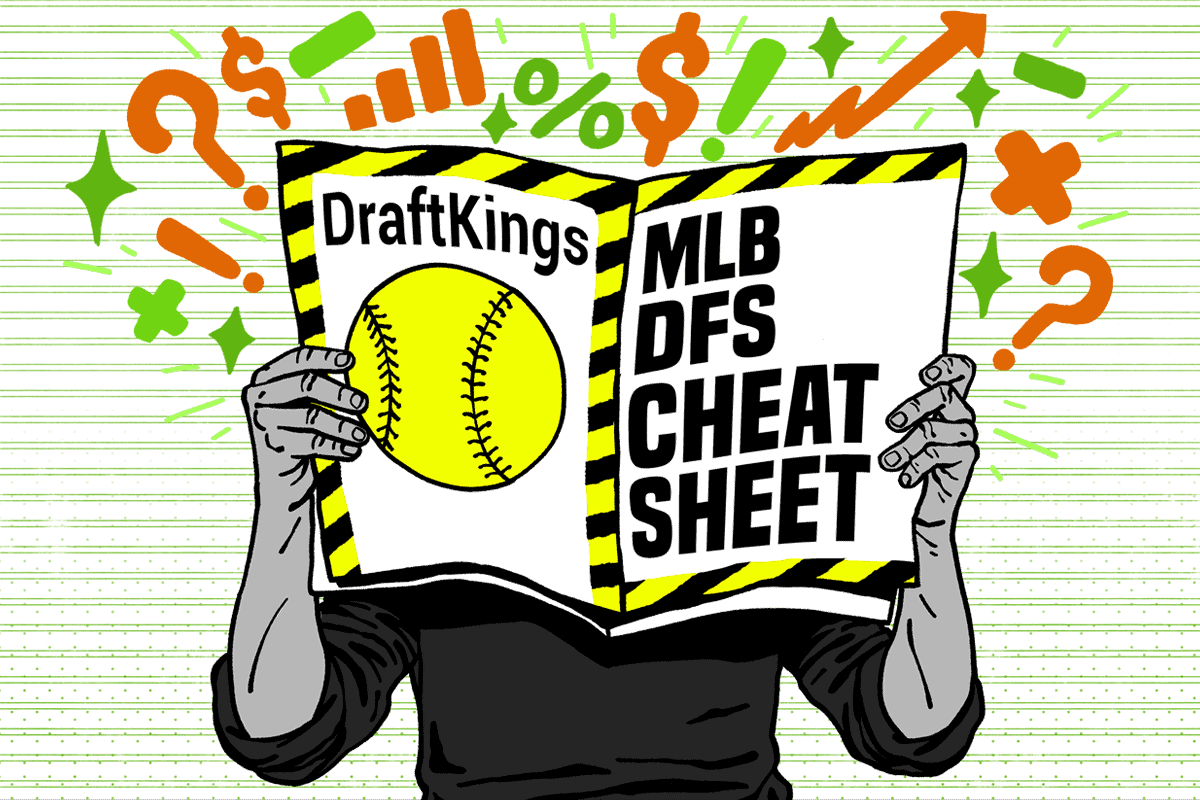Sunday brings the promise of two excellent games and a second chance for NFL DFS gamers to dominate the field or to try to claw back some Saturday expenses. The day includes an excellent-looking pair of games, with the Rams in Tampa Bay to face the Buccaneers in a game with a 48-point total and the home team favored by only 2.5. The later game has been drawing the eyes of the industry all weekend, the Bills are in Kansas City to take on the Chiefs in what is shaping up with Game of the Year hype. The board in Vegas is leaning into the shootout narrative, assigning the contest a whopping 54-point total with the Chiefs standing as one-point favorites. Both games should be high-octane contests with excellent options for NFL DFS lineups on DraftKings and FanDuel tonight.
Groups below are for the individual Sunday main slate, as well as the pair of Showdown contests, in two separate sections. This article focuses on building lineups with a quality foundation by utilizing the powerful Groups and Rules/Limits tools within Fantasy Cruncher. All of the concepts and pairings included below can be applied to hand-building as well, the goal is to create lineups that have high scoring correlation and take advantage of combined outcomes within stacks while limiting the likelihood of building inefficient or negatively correlated entries for a full slate of NFL DFS lineups.
Fantasy Cruncher – New How-To Video
The uptick in questions related to the how-to aspects of Fantasy Cruncher along with several noteworthy new tools demanded a new how-to tutorial video. I put together the above review of all of Fantasy Cruncher’s advanced options with some basic how-to on the constructions, rules, limits, and groups that we use in this article. The tutorial also reviews all of Fantasy Cruncher’s new features and the important distinctions between the various sets of projections that are available.
NFL DFS Lineup Optimizer Picks & Projections
Overview
The Week 1 article featured a deep dive into the general settings menu and various utilities within Fantasy Cruncher, it is still available for anyone who would like to refer back. We will maintain the list of rules and limits below throughout the season, with occasional tweaks, if needed. Each week sees yet another fresh crop of value plays as situations change and injuries create opportunities around the league. These changing roles and emergent value plays are accounted for in the process of creating these groups from week to week. After a large pool of lineups is created utilizing these groups, it is still of critical importance to filter them for factors including ceiling projections and leverage potential, as well as our optimal lineup rates and Boom/Bust potential. Getting to a strong mix of the most optimal positively leveraged plays will be a strong foundation for a large pool of tournament lineups.
DraftKings + FanDuel Stack Rules – Sunday Two-Game Main Slate
This set of rules will force Fantasy Cruncher to build lineups with certain combinations. We are looking to always stack at least one skill player, ideally a pass-catcher, with his quarterback while also playing a skill player from the opposing team in the lineup. The theory behind this build is that a high-scoring stack will require some response from the opposing team to truly deliver a ceiling score in most situations, otherwise the team that is ahead will simply slow down and run out the clock. These rules are applied by completing the sentences with selections from the drop-down menu, they follow a very straightforward logic. Exceptions can be made for teams at the bottom of the rule creation window. After a rule is set, click the blue bar to add it, it will appear at the bottom of the screen as a completed rule.
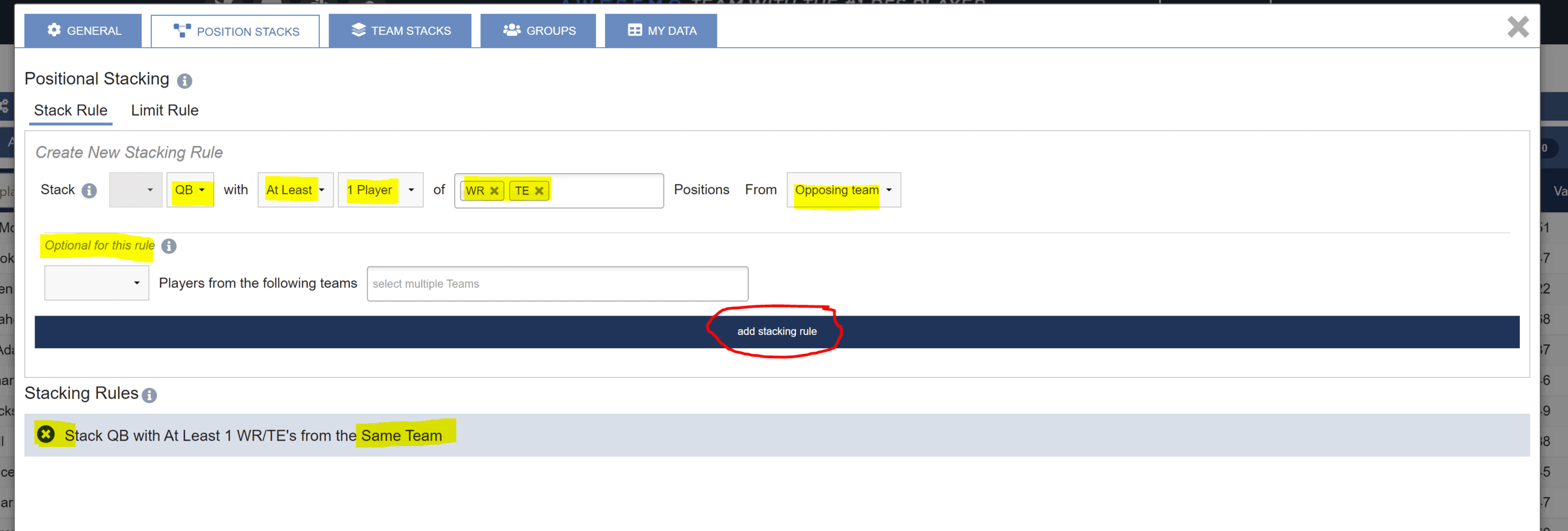
QB with at least one WR/TE from Same Team (note: It is fine to make this two or to utilize two of these, one with WR/TE and one with RB/WR/TE, but we can refine that and get it exactly how we want it for each team via Groups)
QB with at least one RB/WR/TE from Opposing Team
QB with at most zero DST from Same Team (this is more of a personal preference; high-scoring teams and quarterbacks tend to leave their defenses on the field exposing them to simple point-scoring negatives)
Limit Rules
Limit rules can be applied to restrict certain combinations from coming together. This is powerful for limiting multiple running backs from the same team or getting overweight to a certain stack within a lineup.
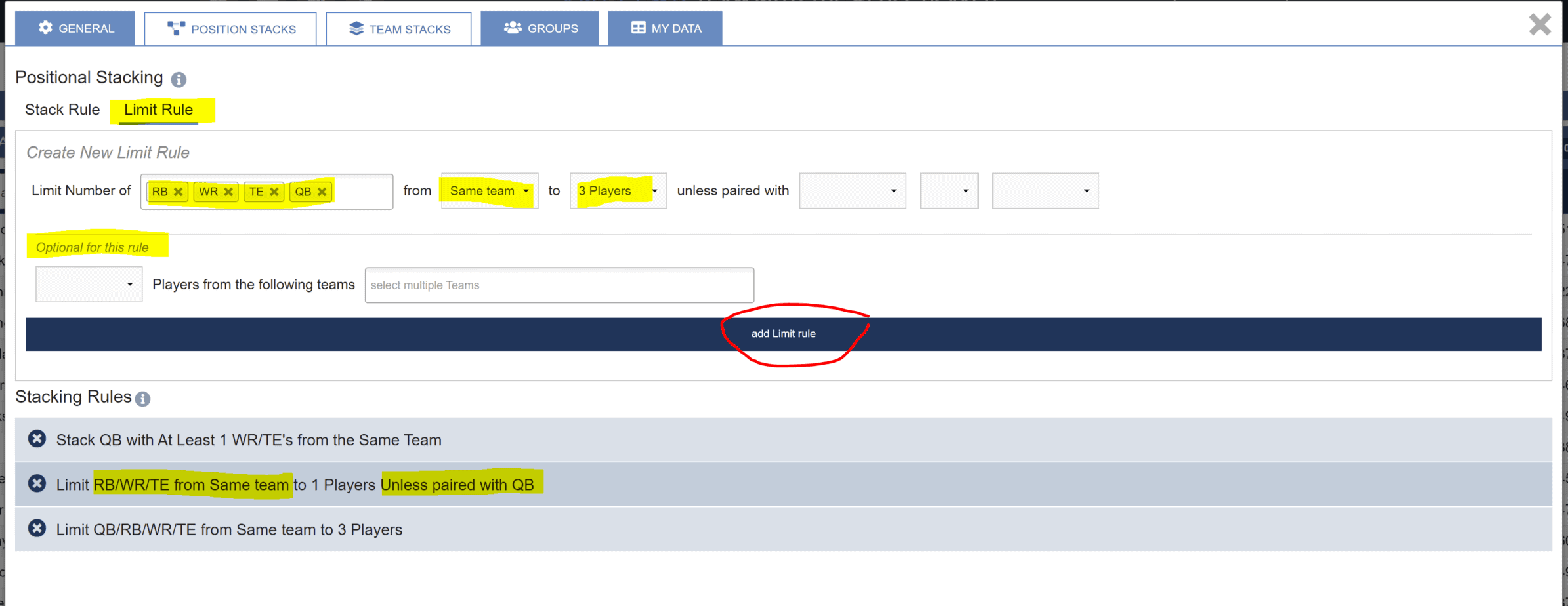
Limit QB/ RB/WR/TE from Same Team to three
Limit RB/WR/TE from Same Team to one unless paired with QB from Same Team OR Opposing Team
Limit RB from Same Team to one (one can also do this with WR in a separate rule that adds an “unless paired with QB or opposing QB,” but it is a personal preference for NFL DFS)
Note: Allow one (or more if desired) offensive player against team defense in Advanced Settings as well, or Fantasy Cruncher will not have enough elbow room in lineup constructions.
Construction
These groups are built by utilizing the quarterback as the KEY player (by clicking the key icon next to his name), with the thinking that the quarterback play is the driving factor in which stack is utilized in that lineup. Built to specification, each team will have two groups, a team group, and an opponent group, both of which utilize the same quarterback, so four groups per game. This is the best approach to truly capture the requirement of playing individual “run-back” plays from the opposing team. A more basic approach would be to include all of the skill players from a game in each quarterback’s group and rely on rules and limits to restrict any potential overflow. It is highly recommended to save the Week 1 groups as a foundation that will be updated for the rest of the season. The recommended groups will include skill players who have an active role in their offense and provide significant correlation with their quarterback’s scoring, quite often bell-cow running backs who do not specialize in the passing game will not be included in groups as they are projected highly and appear on their own in basically correct distributions, while also not always providing the strongest positive correlation plays. Stacking quarterbacks with pass-catchers and allowing running backs to fall into the lanes then crated by settings, available salary and randomness should create a well-distributed set of quality lineups. These groups are updated weekly to account for changes in utilization, schemes, injuries, target shares, and more.
Sunday Update
All of the groups and recommendations below are up to date as of very early Sunday morning. Boosts are included to help create a spread of players that will be viable for selecting upside lineups that have a chance of being differentiated from the field.
Latest NFL DFS Content
- Want to Learn How to Win a DraftKings Milly Maker With Stokastic Sims? Steve Buzzard Will Tell You How
- PrizePicks, Sleeper & Underdog Cheat Sheet: Best More/Less Picks Today for NFL (February 11)
- DraftKings NFL Cheat Sheet: Super Bowl Sims Picks | George Kittle
- NFL Super Bowl 58 DFS Picks: 49ers vs. Chiefs (February 11)
- NFL DFS Captain Picks for Super Bowl 58: Rashee Rice, George Kittle & More
- Stokastic DFS on Youtube
NFL DFS Optimizer Picks: Divisional Round Team Groups
The goal here is to create a large pool of well-built lineups that can be utilized in any large-field GPP contest. Crunch far more lineups than needed and utilize a sorting table in Excel to filter to the best set of lineups for entries. The lineups created in these crunches should provide a broad distribution that includes some of the lower-owned skill players from each stack. Applying boosts is critical in pushing and pulling ownership on individual players within their team’s stacked lineups.
The groups below are designed so that each quarterback will have two groups to create, one with his skill players and another with the opposing team. A more basic approach would be to add them all to one large group with an “at least three” and let rules and limits set things, but there is a more granular level of control in creating them separately.
Utilizing two groups also allows us to place running backs into the “run-back” position in certain teams while not including them in the primary stack for their team. This is useful when there is a situation with an extremely highly projected running back who does not necessarily fit into his team’s passing game. These players are threaded throughout the following construction recommendations.
Buffalo Bills
Key Player: Josh Allen
Setting: Between one and two
Group: Stefon Diggs, Dawson Knox (+50%), Gabriel Davis (+15%), Cole Beasley (+25%), Emmanuel Sanders (+25%), Isaiah McKenzie (+25%)
Opposing Setting: At least one
Group: Tyreek Hill, Travis Kelce (+20%), Byron Pringle (+15%), Mecole Hardman (+15%), Demarcus Robinson (+55%)
Kansas City Chiefs
Key Player: Patrick Mahomes
Setting: At least one
Group: Tyreek Hill, Travis Kelce (+25%), Byron Pringle (+15%), Mecole Hardman (+25%), Demarcus Robinson (+35%)
Opposing Setting: At least one
Group: Stefon Diggs, Dawson Knox (+15%), Gabriel Davis (+15%), Cole Beasley (+15%), Emmanuel Sanders (+15%), Isaiah McKenzie (+25%)
Los Angeles Rams
Key Player: Matthew Stafford
Setting: Between one and two
Group: Cooper Kupp, Cam Akers (-25%), Odell Beckham Jr. (+35%), Van Jefferson Jr. (+25%), Tyler Higbee (+25%), Ben Skowronek (+125%)
Opposing Setting: At least one
Group: Mike Evans (+25%), Rob Gronkowski, Tyler Johnson, Leonard Fournette (-15%), Scotty Miller (+55%), Cyril Grayson (+55%), Cameron Brate (+55%)
Tampa Bay Buccaneers
Key Player: Tom Brady
Setting: Between one and two
Group: Mike Evans, Rob Gronkowski, Tyler Johnson, Leonard Fournette (-15%), Scotty Miller (+55%), Cyril Grayson (+55%), Cameron Brate (+55%)
Opposing Setting: At least one
Group: Cooper Kupp, Cam Akers (-35%), Odell Beckham Jr. (+15%), Van Jefferson Jr. (+15%), Tyler Higbee (+15%), Ben Skowronek (+125%)
NFL DFS Optimizer Picks: Divisional Round Team Groups for DraftKings & FanDuel – Sunday Showdown Slates
Small Sample Central — Trends and Notes
Several of the primary lineup construction notes from previous versions of the Showdown article will continue to be listed in this space, but each week we will attempt to find parallels based on Vegas data and the general game environment from historical contests in the pool of DraftKings Showdown research from 2019 through this week’s contests. It is important to not get too focused on results-based thinking in such a small sample. Quality lineup construction is always the focus, but historical results can help inform some basic decisions in a pricing and ownership vacuum. A quick summary of that previous content:
- According to tracking data for DraftKings Showdown contests over 2019 and 2020, only 17 of 95 slates were won with a quarterback Captain.
- Across the same sample, wide receivers and running backs split the outcomes evenly, with 33 tournament-winning events each.
- Of the 38 times that a wide receiver or tight end was in the winning Captain position, only three of those builds did not include at least one quarterback in a Flex position.
- Thirty-five of 95 winning lineups featured at least one defense, but only two of those featured both defenses.
- Twenty-nine winning lineups featured at least one kicker, but only two of those included both.
- Only eight winning lineups included at least one defense and one kicker, while one person won a tournament with two defenses and a kicker in 2019.
The Sunday slate features games with different enough profiles that they should be reviewed separately. The early contest profiles very much in line with yesterday’s games, coming in with a 48-point total, which leads to the following recap of yesterday’s content:
The 25 sample games between 46.5 and 48.5. Only three of the 25 lineups failed to include a quarterback in any role, continuing the trend we have seen all season. Only three lineups included quarterbacks in the Captain role, however, they are typically far more advantageous in the flex spot. 9 of the 25 lineups included both quarterbacks, a passing-focused build is highly viable in this game format.
Of the 25 winning lineups, 12 of them included a pass-catcher in the Captain role, easily the leading option in the position. Running backs saw victory eight times, while defenses and kickers saw a single victory each. The most common winning lineup construction was a 3-3 even build, with 10 victories, while 4-2 saw another eight, so the clear trend is toward competitive situations on both sides. Kickers continue to be the least useful position, they were included in the winning lineup only seven times, while defenses surprisingly appear in 12 of the 25 winning lineups.
The later game is a 54-point whopper, the historical sample includes 10 games with totals between 52.5 and 55.5, a sample we can expand to 27 games if we include all of the contests with totals above 50. In the 10-game set, four of the winning lineups rostered a pass-catcher at Captain and four of them used running backs, with quarterbacks grabbing the two remaining victories. The primary winning builds in the small sample were even constructions, either 3-3 or 4-2 took seven of the 10 victories.
In the largest sample, 13 of the winning lineups utilized a pass-catcher in the Captain role. Running backs won the day in the Captain job eight times, and quarterbacks picked up the six surplus victories, with kickers and defenses falling short of any wins in the Captain role in contests with totals above 50-points. The six quarterback Captain victories were split evenly between 3-3 builds and 5-1 wipeout constructions, only one of the winning lineups, a 3-3, included the opposing passer. Out of 27 winning lineups in the sample, only one failed to include a quarterback in any role, the position’s value in the flex spot is very clear in this sample, as it has been in everything we have seen throughout the season. 10 of the 26 lineups that included a quarterback added the second signal-caller as well, with the majority of those lineups constructed as 3-3 or 4-2.
As one might expect, defenses are less viable in games with greater than a 50-point total. The position was rostered in only four winning lineups in the 27-game sample. Kickers gain a bit of value in contests of this nature, the position appeared in winning lineups in eight of the 27 contests in the sample. No winning lineup included more than one kicker or defense, and only one lineup included both a kicker and a defense.
The sample favors evenly built lineups, which plays well with the notion of a highly competitive high-scoring game. 14 of the 27 winning lineups were constructed as 3-3 builds and another five lineups were 4-2 setups. 5-1 wipeout constructions were the winner five times, with three of those using quarterbacks in the Captain role. Leaning into evenly constructed lineups that focus on the passing game on both sides seems to be the best approach to games of this size and shape, fortunately that also plays well with the two teams taking the field.
DraftKings + FanDuel Stack Rules
QB with at least one RB/WR/TE from Opposing Team (this will happen naturally in most Showdown constructions, but including the rule will eliminate lineups that feature only an opposing kicker or quarterback)
QB with at least one WR/TE from Same Team (this will happen naturally in a large portion of lineups, but stacking quarterbacks with pass catchers is the easiest way to rack up NFL DFS points. It makes sense to include this rule to force the build, in most situations)
Limit Rules
Limit rules are slightly less important for Showdown slates as there are only two teams to choose from. They are still useful for preventing suboptimal constructions, however. Including the following will help prevent these less likely builds.
Limit QB/RB/WR/TE/DST/K from Same Team to three unless paired with Captain
Limit RB from Same Team to one (this is a rule that can be toggled on and off over multiple crunches, but the preference for this slate would be to use it)
Limit K from Same Game to one
Limit DEF from Same Game to one
Construction Basics
We will utilize Fantasy Cruncher’s Groups utility to create specific builds. The Groups feature includes the ability to designate players as the key to the group, or the player whose use in a position will trigger the group requirements. For Showdown slates this can be utilized to force specific sets of players or positions along with each type of designated Captain. The example below shows a group that utilizes Leonard Fournette in the Captain role as the key player. It will then force all constructions featuring Fournette in the Captain role to include at least three of the players from a group that includes both quarterbacks and positively leveraged options on both sides.
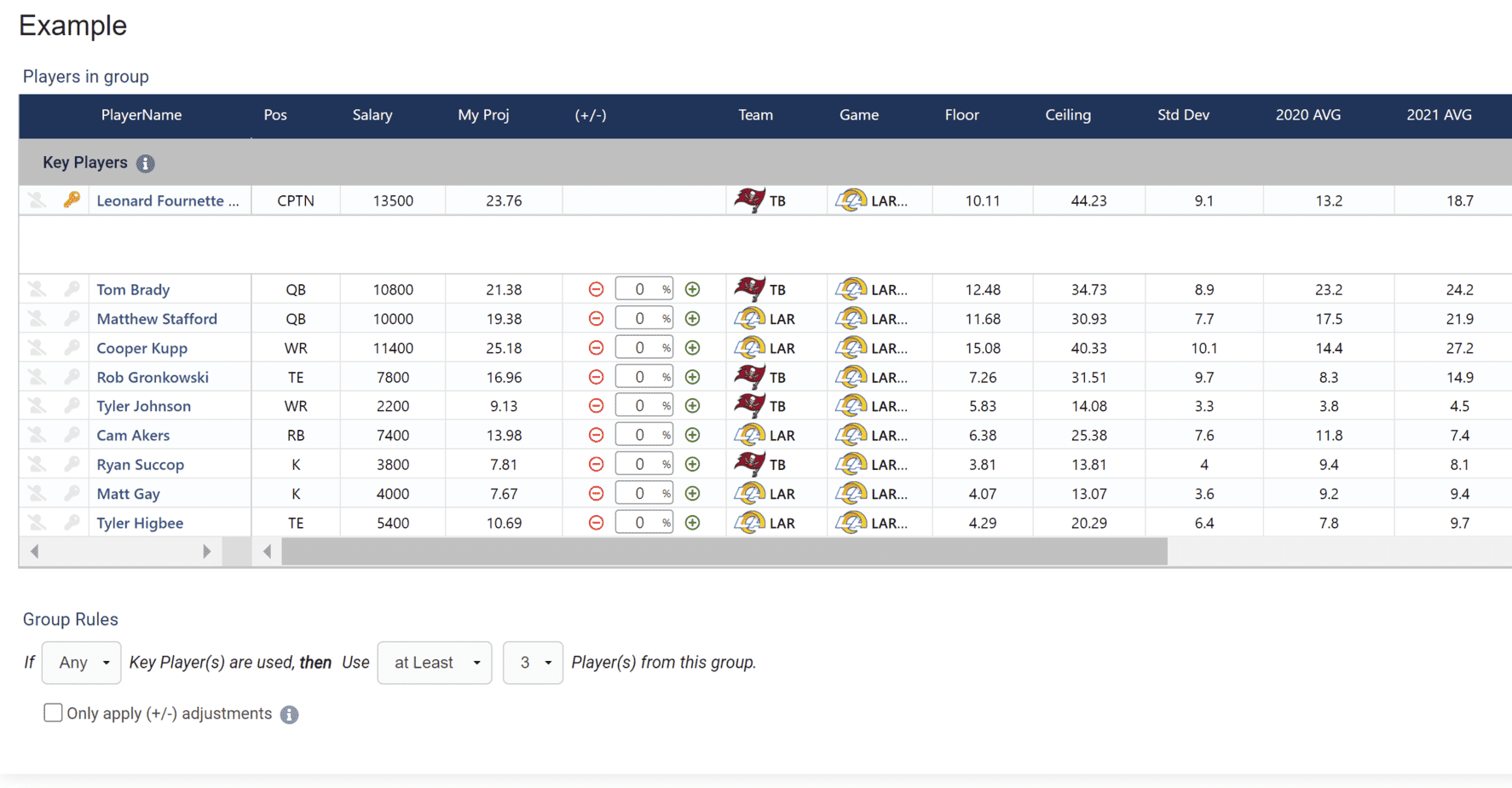
NFL DFS Optimizer Groups & Picks
Unlike multi-game slates, when attacking individual potential game scripts, these groups are better deployed individually for separate crunches that can then be combined into a single pool of lineups. Running them all at once is likely to create conflicting scenarios that will either prevent or limit a full crunch.
Quarterback Inclusion
The first wrinkle in utilizing Groups to create specific constructions is that the tool differentiates between a wide receiver or running back and the same player in the Captain or MVP spot. This requires the creation of a group that adds the Captain version of any likely skill player as the key player, with a rule setting that any lineup featuring any of these players must include one of the quarterbacks in a Flex position. The alternate approach to this problem is to remove all but the skill players from potential inclusion at the Captain spot then create a rule that will simply stack the quarterback with the Captain spot, but that approach is likely more flawed. This group does not currently force quarterbacks when defense or a kicker is used at Captain.
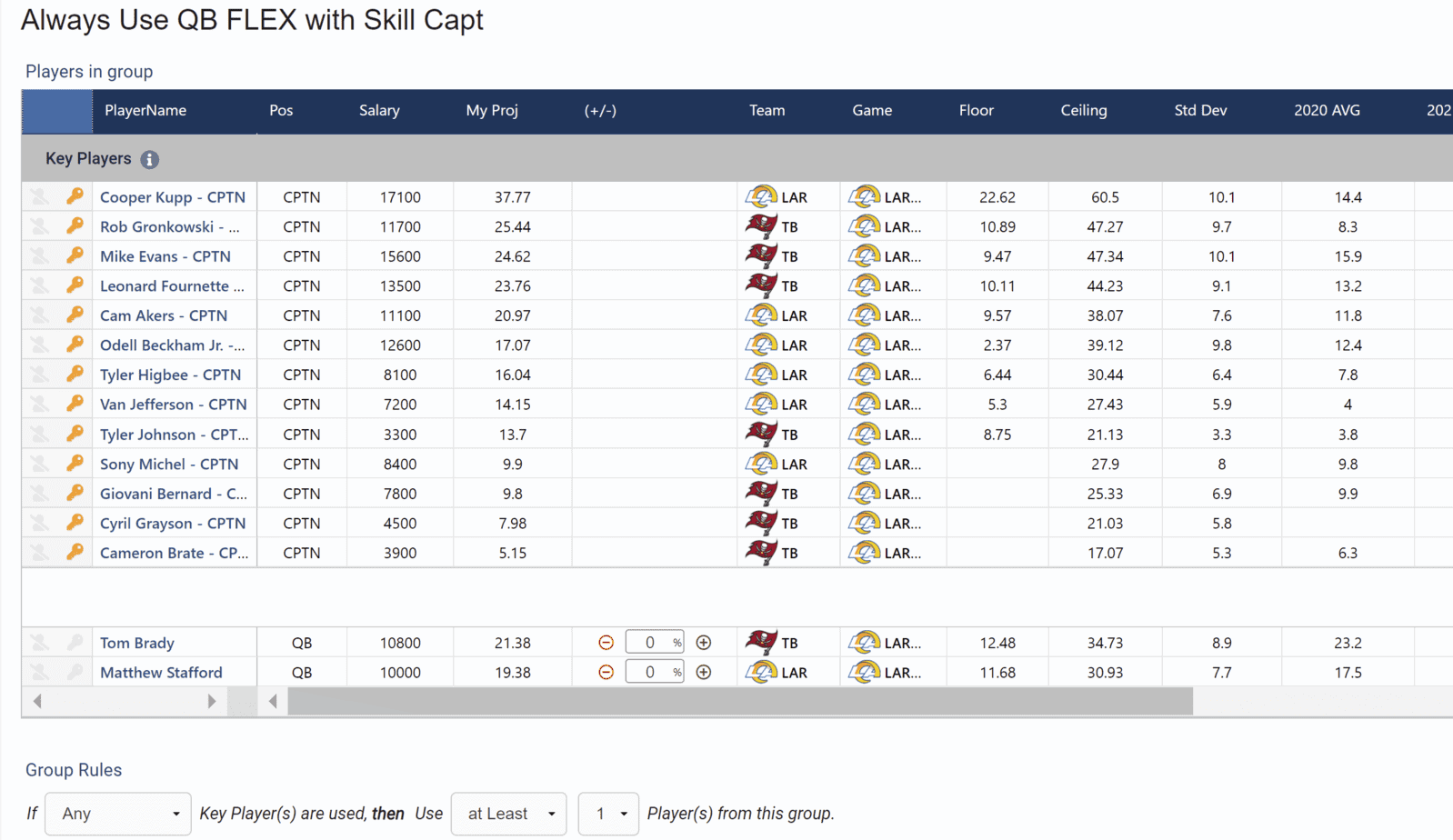
Key Players: All primary skill-players as Captain
Setting: At least one
Group: Matthew Stafford & Tom Brady – Standard versions
This group will result in getting one of the quarterbacks whenever any of the listed primary skill-players is utilized at Captain. To force the quarterback from the same team, multiple groups should be created for skill players from each team utilizing just the quarterback from that team. When quarterbacks appear in Flex positions, the rules and limit settings will kick in to force optimal constructions in the other Flex roles.
Note: Repeat this same concept for the quarterback inclusion group in the second game, grouping all relevant skill players in the Captain roles with the standard versions of quarterbacks Josh Allen and Patrick Mahomes as the group with a setting of at least one.
NFL DFS Game Script – Differentiating Captain Kupp
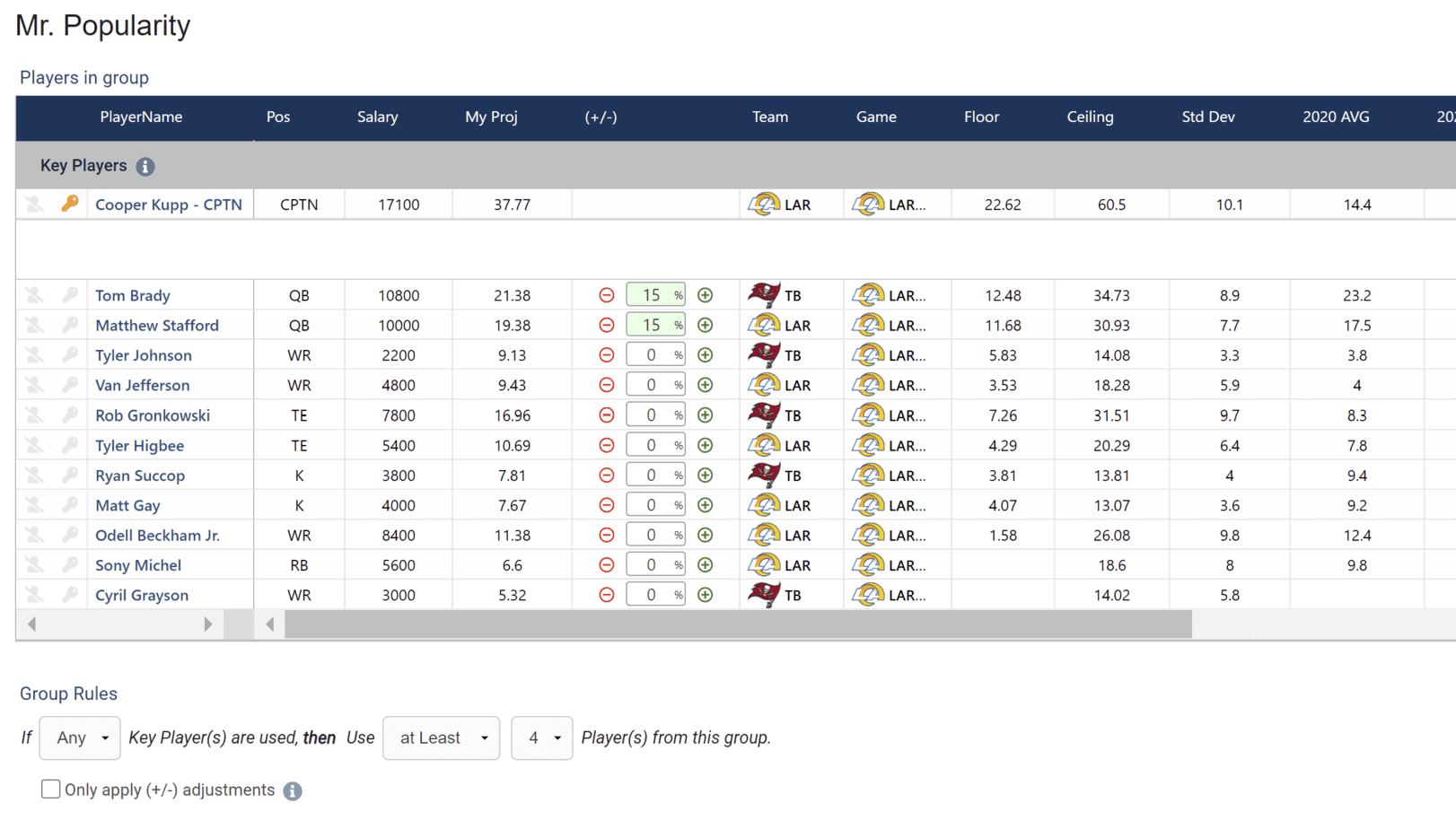
Key Player(s): Cooper Kupp – Captain version
Setting: At least 4
Group: Tom Brady, Matthew Stafford, Tyler Johnson, Van Jefferson Jr., Rob Gronkowski, Tyler Higbee, Ryan Succop, Matt Gay, Odell Beckham Jr., Sony Michel, Cyril Grayson
This group looks to push players with positive leverage in the flex role into lineups that feature popular Captain play Cooper Kupp. The Rams wide receiver is the top option on the board with a 16.5% optimal lineup rate in the role, he has a ridiculous 43% probability of being the slate’s leading scorer in raw fantasy points, and he will be owned twice as frequently in the Captain role as any other player on the board at 18.6%. Differentiation in lineups with Kupp will be key, this group can be run with a setting of either at least four or at least three, depending on what additional premium players one may desire.
Latest NFL DFS Content
- Want to Learn How to Win a DraftKings Milly Maker With Stokastic Sims? Steve Buzzard Will Tell You How
- PrizePicks, Sleeper & Underdog Cheat Sheet: Best More/Less Picks Today for NFL (February 11)
- DraftKings NFL Cheat Sheet: Super Bowl Sims Picks | George Kittle
- NFL Super Bowl 58 DFS Picks: 49ers vs. Chiefs (February 11)
- NFL DFS Captain Picks for Super Bowl 58: Rashee Rice, George Kittle & More
- Stokastic DFS on Youtube
NFL DFS Gameflow – Shootout
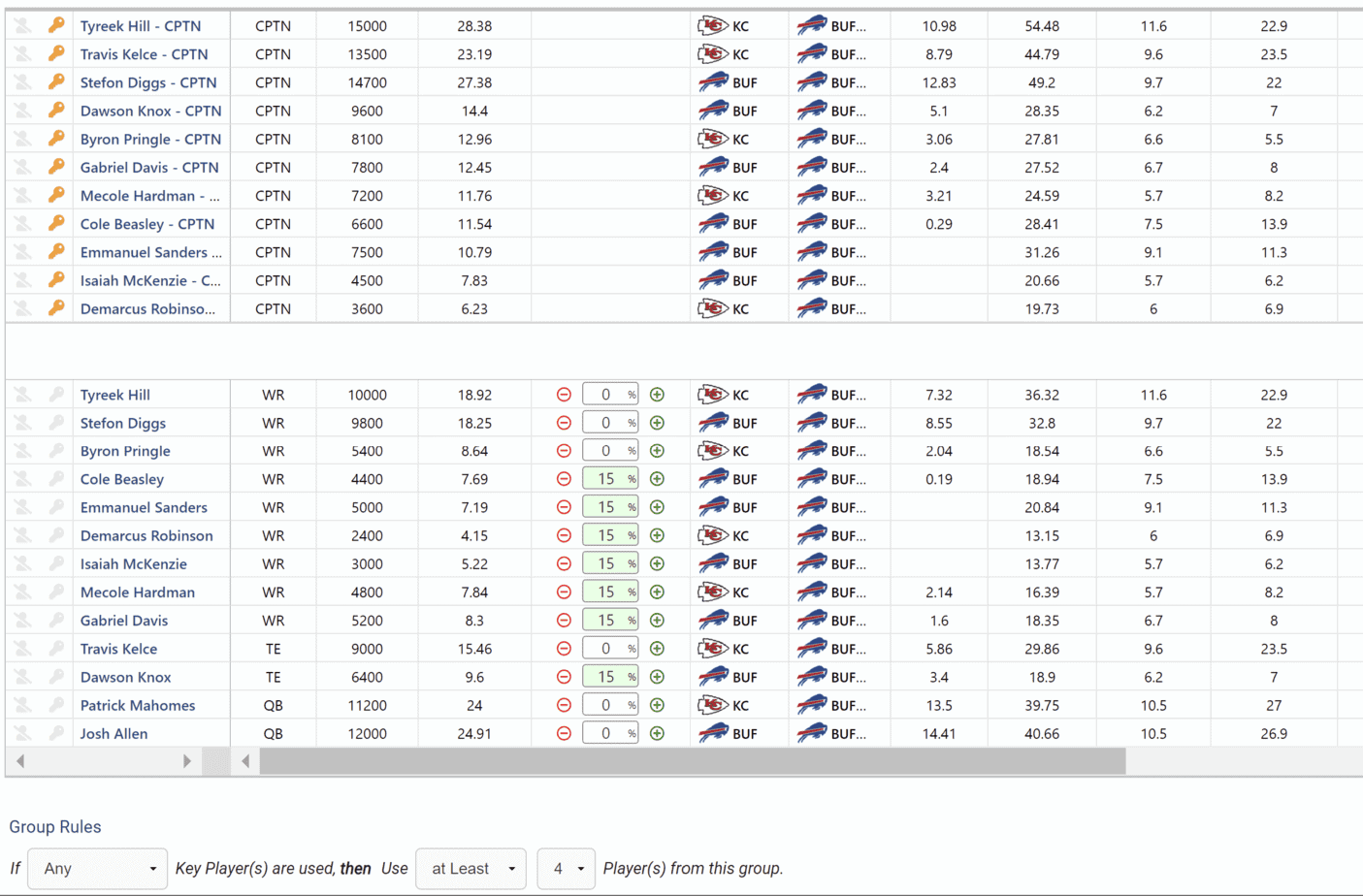
Key Player(s): All primary pass-catchers – Captain versions
Setting: At least four
Group: All primary pass-catchers – Standard versions, Patrick Mahomes, Josh Allen, Matt Gay, Ryan Succop
This group attempts to rope off the upside of a shootout game while giving a minor bump to the less-likely options with the boost utility. The group should result in evenly built constructions that lean into the passing game while providing a bit of differentiation through those lower-owned options. The group will create expensive lineups, which should lead to further differentiation in the final non-grouped roster spot.
Thanks for reading to the end of this article! If you appreciate this free content and want to see more of it every day, you can help us out by sharing this article on social media!
[NFLPAGE]






